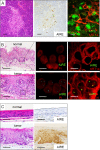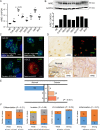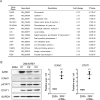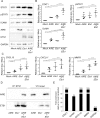AIRE is induced in oral squamous cell carcinoma and promotes cancer gene expression
- PMID: 32012175
- PMCID: PMC6996854
- DOI: 10.1371/journal.pone.0222689
AIRE is induced in oral squamous cell carcinoma and promotes cancer gene expression
Abstract
Autoimmune regulator (AIRE) is a transcriptional regulator that is primarily expressed in medullary epithelial cells, where it induces tissue-specific antigen expression. Under pathological conditions, AIRE expression is induced in epidermal cells and promotes skin tumor development. This study aimed to clarify the role of AIRE in the pathogenesis of oral squamous cell carcinoma (OSCC). AIRE expression was evaluated in six OSCC cell lines and in OSCC tissue specimens. Expression of STAT1, ICAM1, CXCL10, CXCL11, and MMP9 was elevated in 293A cells stably expressing AIRE, and conversely, was decreased in AIRE-knockout HSC3 OSCC cells when compared to the respective controls. Upregulation of STAT1, and ICAM in OSCC cells was confirmed in tissue specimens by immunohistochemistry. We provide evidence that AIRE exerts transcriptional control in cooperation with ETS1. Expression of STAT1, ICAM1, CXCL10, CXCL11, and MMP9 was increased in 293A cells upon Ets1 transfection, and coexpression of AIRE further increased the expression of these proteins. AIRE coprecipitated with ETS1 in a modified immunoprecipitation assay using formaldehyde crosslinking. Chromatin immunoprecipitation and quantitative PCR analysis revealed that promoter fragments of STAT1, ICAM1, CXCL10, and MMP9 were enriched in the AIRE precipitates. These results indicate that AIRE is induced in OSCC and supports cancer-related gene expression in cooperation with ETS1. This is a novel function of AIRE in extrathymic tissues under the pathological condition.
Conflict of interest statement
The authors have declared that no competing interests exist.
Figures






Similar articles
-
A novel miR-365-3p/EHF/keratin 16 axis promotes oral squamous cell carcinoma metastasis, cancer stemness and drug resistance via enhancing β5-integrin/c-met signaling pathway.J Exp Clin Cancer Res. 2019 Feb 19;38(1):89. doi: 10.1186/s13046-019-1091-5. J Exp Clin Cancer Res. 2019. PMID: 30782177 Free PMC article.
-
Epigenetic alterations of the keratin 13 gene in oral squamous cell carcinoma.BMC Cancer. 2014 Dec 20;14:988. doi: 10.1186/1471-2407-14-988. BMC Cancer. 2014. PMID: 25527207 Free PMC article.
-
Ets transcription factors regulate AIRE gene promoter.Biochem Biophys Res Commun. 2006 Sep 22;348(2):768-74. doi: 10.1016/j.bbrc.2006.07.135. Epub 2006 Jul 31. Biochem Biophys Res Commun. 2006. PMID: 16890195
-
AIRE activated tissue specific genes have histone modifications associated with inactive chromatin.Hum Mol Genet. 2009 Dec 15;18(24):4699-710. doi: 10.1093/hmg/ddp433. Epub 2009 Sep 10. Hum Mol Genet. 2009. PMID: 19744957 Free PMC article.
-
Aberrant promoter hypermethylation of the CHFR gene in oral squamous cell carcinomas.Oncol Rep. 2009 Nov;22(5):1173-9. doi: 10.3892/or_00000552. Oncol Rep. 2009. PMID: 19787237
Cited by
-
Causal associations of MICB, CTSA, and MMP9 proteins with oral cancer: Mendelian randomization study.Sci Rep. 2024 Oct 27;14(1):25645. doi: 10.1038/s41598-024-77042-0. Sci Rep. 2024. PMID: 39465349 Free PMC article.
-
Brief research report: ETS-1 blockade increases ICAM-1 expression in activated human retinal endothelial cells.Front Ophthalmol (Lausanne). 2024 Apr 16;4:1384428. doi: 10.3389/fopht.2024.1384428. eCollection 2024. Front Ophthalmol (Lausanne). 2024. PMID: 38984117 Free PMC article.
-
CellCountCV-A Web-Application for Accurate Cell Counting and Automated Batch Processing of Microscopic Images Using Fully Convolutional Neural Networks.Sensors (Basel). 2020 Jun 29;20(13):3653. doi: 10.3390/s20133653. Sensors (Basel). 2020. PMID: 32610652 Free PMC article.
-
A systematic and comprehensive analysis of colorectal squamous cell carcinoma: Implication for diagnosis and treatment.Cancer Med. 2022 Jun;11(12):2492-2502. doi: 10.1002/cam4.4616. Epub 2022 Feb 23. Cancer Med. 2022. PMID: 35194959 Free PMC article.
-
The Role of CXCL11 and its Receptors in Cancer: Prospective but Challenging Clinical Targets.Cancer Control. 2024 Jan-Dec;31:10732748241241162. doi: 10.1177/10732748241241162. Cancer Control. 2024. PMID: 38533911 Free PMC article. Review.
References
Publication types
MeSH terms
Substances
LinkOut - more resources
Full Text Sources
Medical
Research Materials
Miscellaneous

